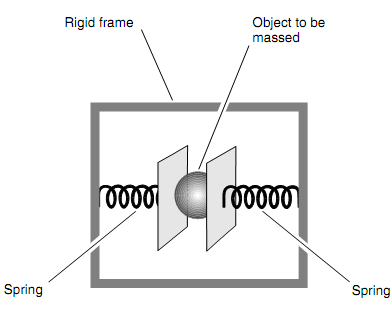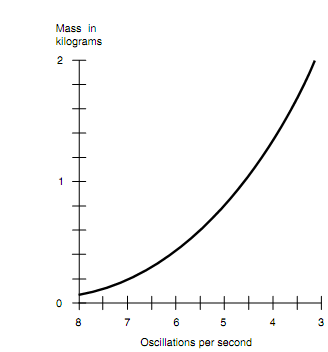How mass is determined:
The easiest way to establish the mass of an object is to measure it with a scale. Though, this isn't the finest way. Whenever you put something on a scale, you are calculating that object's weight in the gravitational field of the Earth. The intensity of such field is, for many practical reasons the same wherever you go on the planet. When you want to get picayune about it, however, there is a slight variation of weight for a given mass with changes in the geographic place. A scale with adequate accuracy will show a particular object, like a lead shot, as being a tiny bit heavier at the equator than at the north pole. The weight changes, though the mass does not.
Assume that you are on an interplanetary journey, coasting all along on your way to Mars or in orbit around Earth, and the whole thing in your space vessel is weightless. How can you calculate the mass of a lead shot under these circumstances? When floats around in the cabin along with your body, the pencils you write with, and the whole thing else that is not tied down. You are conscious that the lead shot is more massive than, say, a pea, though how can you measure it to be certain?
One way to measure mass, separately of gravity, includes using a pair of springs set in a frame with the object placed in the middle as shown in figure below.

Figure: Mass can be measured by setting an object to oscillate between a pair of springs in a weightless environment.
When you put something among the springs and pull it to one side, then the object oscillates. You try this with a pea, and the springs oscillate quickly. You try it again with a lead shot, and springs oscillate gradually. This "mass meter" is anchored to a desk in the space ship's cabin that is in return anchored to the "floor" (though you might define this in a weightless environment). Anchoring the scale keeps the entire apparatus from wagging back and forth in midair after you begin the object oscillating.
A scale of this type should be calibrated in advance before it can render meaningful figures for masses of objects. The calibration will outcome in a graph which shows oscillation period or frequency as a function of the mass. Once this calibration is completed in a weightless environment and the graph has been drawn, you can use it to measure the mass of whatever thing in reason. The readings will be thrown off when you try to use the "mass meter" on Earth, the Moon, or Mars since there is an exterior force, gravity, acting on the mass. The alike problem will take place when you try to use the scale whenever the space ship is accelerating instead of than merely coasting or orbiting via space.
PROBLEM:
Assume that you put an object in a "mass meter" similar to the one shown in figure above. Also assume that the mass-versus-frequency calibration curve for this device has been determined and looks like the graph of figure as shown below. The object oscillates with a frequency of 5 complete cycles per second (i.e., 5 hertz or 5 Hz).What is the estimated mass of this object?
SOLUTION:
Place the frequency on the horizontal scale. Now draw a vertical line (or place a ruler) parallel to the vertical (mass) axis. Note that where this straight line intersects the curve. Now draw a horizontal line from this point toward the left until it intersects the mass scale. Read the mass off the scale. It is around 0.8 kg, as shown in figure shown below.

Figure: Graph of mass versus oscillation frequency for a hypothetical "mass meter"
